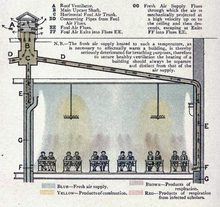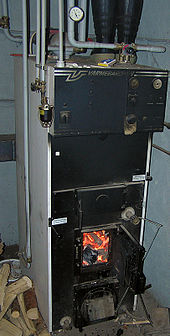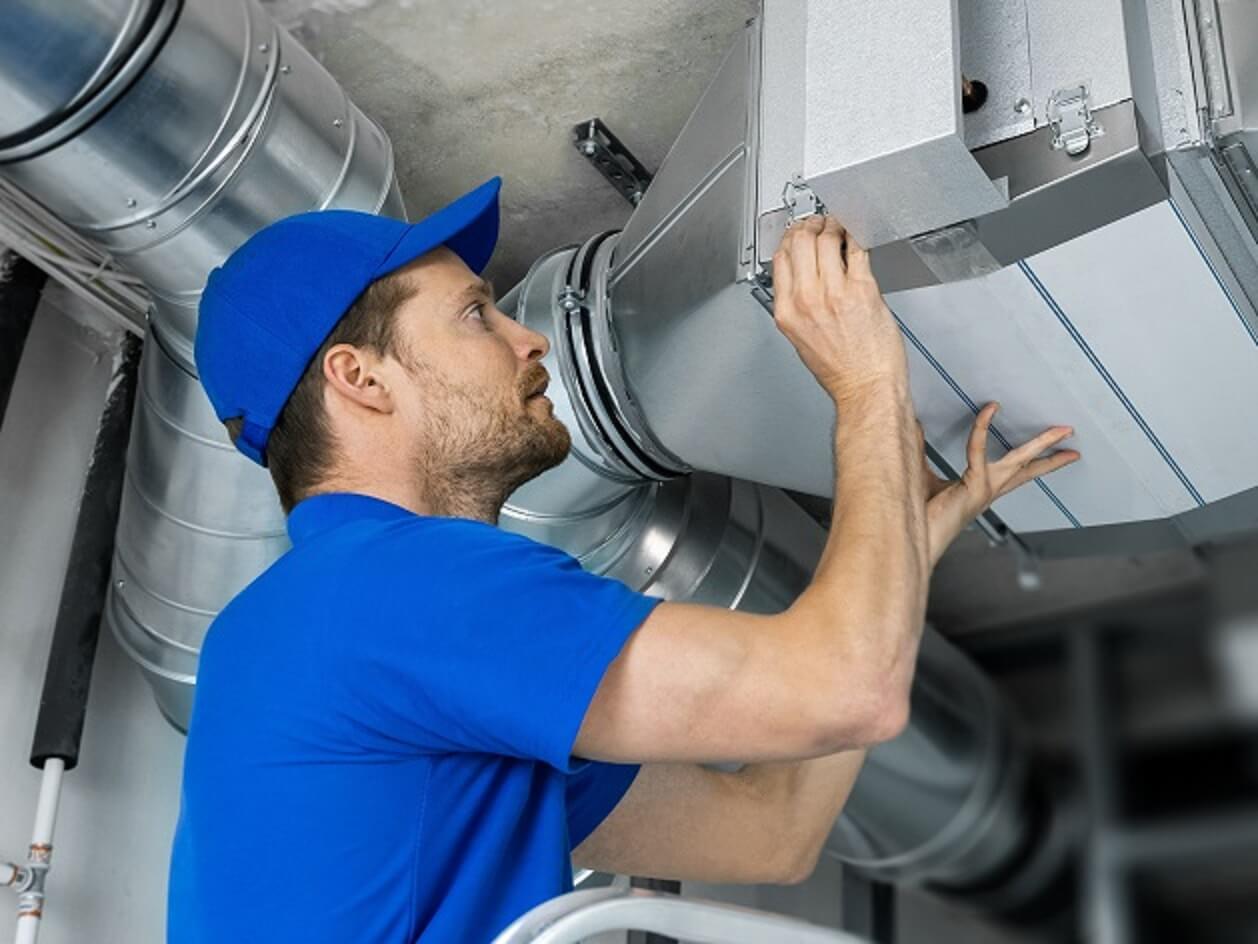hvac-تهویه
HVAC (heating, ventilation, and air conditioning) is the technology of indoor and vehicular environmental comfort. HVAC system design is a subdiscipline of mechanical engineering, based on the principles of thermodynamics, fluid mechanics, and heat transfer. Refrigeration is sometimes added to the field’s abbreviation as HVAC&R or HVACR, or ventilating is dropped as in HACR (such as the designation of HACR-rated circuit breakers).
HVAC is important in the design of medium to large industrial and office buildings such as skyscrapers and in marine environments such as aquariums, where safe and healthy building conditions are regulated with respect to temperature and humidity, using fresh air from outdoors.

Ventilation on the downdraught system, by impulsion, or the ‘plenum’ principle, applied to schoolrooms (1899)
Heating, ventilating, and air conditioning is based on inventions and discoveries made by Nikolay Lvov, Michael Faraday, Willis Carrier, Reuben Trane, James Joule, William Rankine, Sadi Carnot, and many others.[1]
The invention of the components of HVAC systems went hand-in-hand with the industrial revolution, and new methods of modernization, higher efficiency, and system control are constantly introduced by companies and inventors worldwide. The three central functions of heating, ventilating, and air-conditioning are interrelated, especially with the need to provide thermal comfort and acceptable indoor air quality within reasonable installation, operation, and maintenance costs. HVAC systems can provide ventilation, reduce air infiltration, and maintain pressure relationships between spaces. The means of air delivery and removal from spaces is known as room air distribution.[2]
The starting point in carrying out an estimate both for cooling and heating depends on the exterior climate and interior specified conditions. However before taking up the heat load calculation, it is necessary to find fresh air requirements for each area in detail, as pressurization is an important consideration.
In modern buildings the design, installation, and control systems of these functions are integrated into one or more HVAC systems. For very small buildings, contractors normally capacity engineer and select HVAC systems and equipment. For larger buildings, building services designers and engineers, such as mechanical, architectural, or building services engineers analyze, design, and specify the HVAC systems, and specialty mechanical contractors fabricate and commission them. Building permits and code-compliance inspections of the installations are normally required for all sizes of buildings.[citation needed]
Although HVAC is executed in individual buildings or other enclosed spaces (e.g. think NORAD’s underground headquarters), the equipment involved is in some cases an extension of a larger district heating (DH) or district cooling (DC) network, or a combined DHC network. In such cases, the operating and maintenance aspects are simplified and metering is necessary to bill for the energy that is consumed, and in some cases energy that is returned to the larger system. (For example, in a DHC network at a given time a building may be utilizing chilled water for air conditioning, but the warm water it returns may be utilized by another building for heating or the overall DH portion of the DHC network, likely with energy added to boost the temperature.)[3][4][5]
Basing HVAC on a larger network helps provide an economy of scale that is often not possible for individual buildings, for utilizing renewable energy sources such as solar heat,[6][7][8] winter’s cold,[9] the cooling potential in some places of lakes or seawater for free cooling, and the enabling function of seasonal thermal energy storage.
The HVAC industry is a worldwide enterprise, with roles including operation and maintenance, system design and construction, equipment manufacturing and sales, and in education and research. The HVAC industry was historically regulated by the manufacturers of HVAC equipment, but regulating and standards organizations such as HARDI, ASHRAE, SMACNA, ACCA, Uniform Mechanical Code, International Mechanical Code, and AMCA have been established to support the industry and encourage high standards and achievement.
Contents
Heating
A heater is an object that emits heat or causes another body to achieve a higher temperature. In a household or domestic setting, heaters are usually appliances whose purpose is to generate heating (i.e. warmth). Other types of heaters are Ovens and Furnaces.
Heaters exists for all states of matter, including solids, liquids and gases. There are 3 types of heat transfer: convection, conduction and radiation.
The opposite of a heater (for warmth) is an air cooler (for cold) (see air conditioning) used to keep the user cooler than the temperature originally surrounding them.
There are many different types of heating systems. Central heating is often used in cool climates to heat houses and public buildings. Such a system contains a boiler, furnace, or heat pump to warm water, steam, or air in a central location such as a furnace room in a home or a mechanical room in a large building. The use of water as the heat transfer medium is known as hydronics. These systems also contain either duct work for forced air systems or piping to distribute a heated fluid to radiators to transfer this heat to the air. The term radiator in this context is misleading since most heat transfer from the heat exchanger is by convection, not radiation. The radiators may be mounted on walls or installed within the floor to give floor heat.
Most modern hot water boiler heating systems have a circulator, which is a pump, to move hot water through the distribution system. This distribution system can be via radiators, convectors (baseboard), hot water coils (hydro-air) or other heat exchangers. The heated water can also supply an auxiliary heat exchanger to supply hot water for bathing and washing.
Warm air systems distribute heated air through duct work systems of supply and return air through metal or fiberglass ducts. Many systems use the same ducts to distribute air cooled by an evaporator coil for air conditioning. The air supply is typically filtered through air cleaners to remove dust and pollen particles.
One type of heat source is electricity, typically heating ribbons made of high resistance wire. This principle is also used for baseboard heaters, and portable heaters. Electrical heaters are often used as backup or supplemental heat for heat pump (or reverse heating) systems.
The heat pump gained popularity in the 1950s.[where?] Heat pumps can extract heat from the exterior air (air source) or from the ground (ground source). Initially, heat pump HVAC systems were used in moderate climates, but with improvements in low temperature operation and reduced loads due to more efficient homes, they are increasing in popularity in other climates. Heat pumps can be air to air, air to water, water to air and water to water systems. Water on the supply side of the heat pump is typically geothermal energy from ground water, either surface water or PEX tubing buried in a trench. Due to the construction of wells and site work, geothermal systems are typically more expensive to purchase and install than conventional heating systems.[citation needed]
The invention of central heating is often credited to the ancient Romans, who installed systems of air ducts called hypocausts in the walls and floors of public baths and private villas.[10]
The use of furnaces, space heaters and boilers as means of indoor heating may result in incomplete combustion and the emission of carbon monoxide, nitrogen oxides, formaldehyde, volatile organic compounds, and other combustion byproducts. Incomplete combustion occurs when there is insufficient oxygen; the inputs are fuels containing various contaminants and the outputs are harmful byproducts, most dangerously carbon monoxide which is a tasteless and odorless gas with serious adverse health effects.[11]
Without proper ventilation, carbon monoxide can be lethal at concentrations of 1000 ppm (0.1%). However, at several hundred ppm, carbon monoxide exposure induces headaches, fatigue, nausea, and vomiting. Carbon monoxide binds with hemoglobin in the blood, forming carboxyhemoglobin, reducing the blood’s ability to transport oxygen. The primary health concerns associated with carbon monoxide exposure are its cardiovascular and neurobehavioral effects. Carbon monoxide can cause atherosclerosis; the hardening of arteries, and can also trigger heart attacks. Neurologically, carbon monoxide exposure reduces hand to eye coordination, vigilance, and continuous performance. It can also affect time discrimination.[12] تهویه


